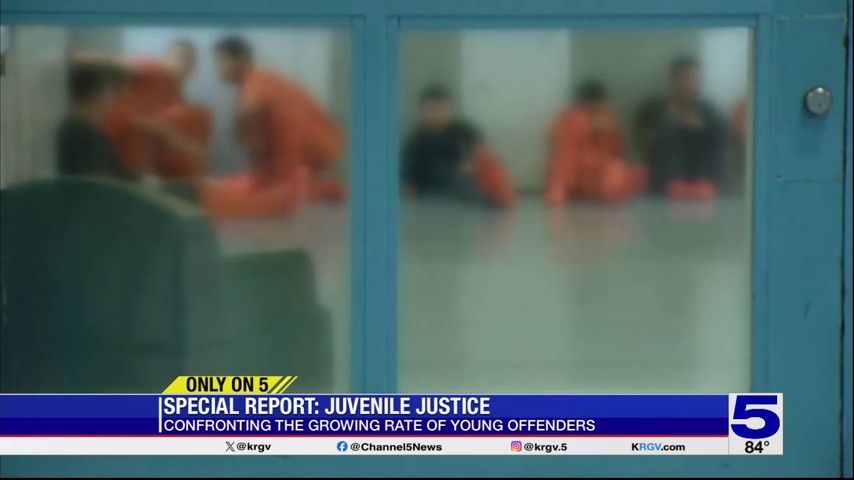Juvenile Justice: Cameron County authorities confronting growing rate of young offenders
The justice system in Cameron County is facing a growing challenge as more children as young as 10 are landing in the juvenile detention center.
Officials are looking for ways to hold them accountable while trying to steer them away from crime.
The juvenile offenders are sent to the Darrell B. Hester Juvenile Detention Center in San Benito.
Manny Delgado was booked into the facility when he was 12 years old after he was involved in a fight.
"It was definitely a scary experience at the start,” Delgado said.
Delgado spent four months at the detention center, and seven more months at a program out the Rio Grande Valley.
“It was really tough the first time I had this bad perception of myself,” Delgado said. “People were telling me, ‘you messed up once, and you're just going to be in and out of the system.’"
RELATED STORY: Juvenile Justice: A look at the Cameron County juvenile detention center
Cameron County DA says juvenile laws should be updated
Over the last three years, the Darrell B Hester Juvenile Detention Center has seen an increase in offenses. In 2024, there was a total of 897, compared to 809 offenses in 2022.
The majority of offenders are kids caught with vapes pens that contain THC.
The increase has caused concern for those who work with young offenders, including Cameron County District Attorney Luis Saenz.
“I can tell you that the feeling of the community is that not enough is being done to deal with the influx of juvenile criminal conduct,” Saenz said.
Saenz believes there's a serious problem with young offenders and repeat crimes, and that laws need to be updated to modern problems.
The Juvenile Justice Code was enacted in 1975, and it says a child can be released as long as they have an adult to supervise them.
“The juvenile back then was committing simple acts of criminal mischief, simple misdemeanor acts, and that's what they're premised on,” Saenz said.
Saenz said he feels more needs to be done when it comes to holding young offenders accountable.
“I can't give you the name of the juvenile, I can't tell you who he is, I can't post his picture,” Saenz said. “The public doesn't know who they are, and they take advantage of that."
Saenz said he is advocating for change.
"It's very problematic because the premise doesn't match the reality,” Saenz said. “The premise was, ‘let's rehabilitate these youngsters, let's not felonize them,’ and I get that, I understand that. That is a good premise, but that premise is based on the fact that they weren't committing capital murder."
Saenz said the community needs to be more involved in demanding more from state lawmakers, and “asking them to do something by putting some teeth into the juvenile system that is failing our community."
Saenz said juveniles have learned how to manipulate the system
“They have come to learn how to stand in front of the judge, hang their head, and cry a little bit and say they're not gonna do it again, and they're released and they go home, "Saenz said.
‘The goal is to not criminalize children’
Adela Kowalski-Garza is the judge those young offenders in Cameron County see.
While she agrees the kids coming into her courtroom have changed, Kowalski-Garza said she believes in the process she's following.
“Sometimes the DA’s office, or even probation, they want a felony adjudication after the six months — and I sometimes give them another chance. And that is sometimes problematic for some people,” Kowalski-Garza said.
Kowalski-Garza took over as judge of 484th juvenile court in 2022. Since then, she said she's paid attention to the young offenders coming down her halls.
“The majority are just good kids making a bad choice,” Kowalski-Garza said. “I do give a lot of chances, but I think that my ideas are working — and in my opinion they're working. Just give it time."
Kowalski-Garza said she also feels the juvenile justice system is not a one size fits all process because everyone child different
“I look at the juvenile's background, including mental illness… and when there's instability in the house it's very difficult to work with a child that does not have the structure in their home,” Kowalski-Garza said.
Kowalski-Garza said while the laws are the same, courts treat children and adults differently.
“It's a hybrid of two laws, it's criminal on one side and on the other hand, it's civil because we don't want to criminalize children,” Kowalski-Garza said.
The judge also said they've needed to make changes at the juvenile detention center to evolve with offenders.
“Because of safety protocols and because some children have become more violent lately in the last decade or so, the security measures are very similar to the adult system,” Kowalski-Garza said.
Kowalski-Garza’s court offers different programs to help rehabilitate a child. This includes counseling services, therapy through arts and crafts and music.
“And I try to let them know that those chains that they're wearing, those uniforms they're wearing does not define them,” Kowalski-Garza said.
Dr. Alcides Amador is a child and adolescent psychiatrist and assistant professor of psychiatry at UTRGV. He said he agrees with Judge Kowalski-Garza that a crime should not define a child.
Amador said juvenile offenders now deal with more complex issues that range from families under financial strain, or substance abuse in the home.
“That means that the child doesn't have the most positive role models set in their homes, so it might lead them to have an increased risk of falling to criminality themselves,” Amador said. “With the current state of how are things are with our economy — rising prices — there could be a connection but it's very complex."
Amador said high school students are more aware of issues at home and can be influenced by social media. He recommends parents pay attention to how their children are spending their time, and the type of influence it may have on them.
Second chances
Delgado said he still reflects on his moments with the juvenile system. He said it wasn't until the second time he was detained that helped him change after talking with another teenager who was a repeat offender
“He was telling me, ‘you know you don't want this for you, you see all of these other people here, maybe they're here for crime reasons. Maybe they're here because they have no one to support them, you can go back home,’” Delgado said.
Delgado said he feels it was his upbringing of going through the foster care system that had an impact on him and his decisions.
“When I look at my past compared to where I am now, it's been a lot of progress,” Delgado said.
Delgado is now a 20-year-old martial arts instructor and a first degree black belt. He's also earned a bachelor's degree in criminal justice.
Delgado said his motivation was to set an example for his siblings now that he's working towards his dream job.
“Every little thing that's happened has helped build me to the person I am today,” Delgado said. “I'm here, I’m able to support myself, I’m able to support my brother. I’m in a very good position, I’ve worked hard."
While some young offenders — like Delgado — find a life away from crime, others don't.
Two juveniles were tried as adults and convicted of murder in Cameron County in 2024.
Seven other juveniles are currently in the court system who will be tried as adults on charges of murder and aggravated robbery.
Saenz and Kowalski-Garza both said there is a critical need for a balanced juvenile justice system that guides more young lives away from crime.
Watch the video above for the full story.





